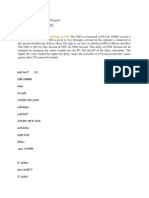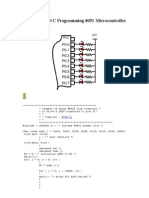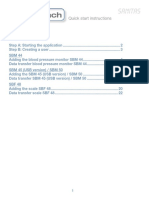0% found this document useful (0 votes)
43 views2 pages9.flashing of LEDS.
1. The document describes a procedure to develop a C program to blink LEDs connected to a development board using delays.
2. It involves creating a new project in IAR IDE, writing a C program with LED initialization and toggle functions, building and downloading the hex file using a flash loader, and observing the LEDs blinking with a delay.
3. The program initializes the LEDs on a development board by enabling the clock and setting the pin mode, and toggles the LEDs in a continuous loop with a delay function to vary the blinking speed.
Uploaded by
Evil Psycho YTCopyright
© © All Rights Reserved
We take content rights seriously. If you suspect this is your content, claim it here.
Available Formats
Download as PDF, TXT or read online on Scribd
0% found this document useful (0 votes)
43 views2 pages9.flashing of LEDS.
1. The document describes a procedure to develop a C program to blink LEDs connected to a development board using delays.
2. It involves creating a new project in IAR IDE, writing a C program with LED initialization and toggle functions, building and downloading the hex file using a flash loader, and observing the LEDs blinking with a delay.
3. The program initializes the LEDs on a development board by enabling the clock and setting the pin mode, and toggles the LEDs in a continuous loop with a delay function to vary the blinking speed.
Uploaded by
Evil Psycho YTCopyright
© © All Rights Reserved
We take content rights seriously. If you suspect this is your content, claim it here.
Available Formats
Download as PDF, TXT or read online on Scribd
/ 2



















































































